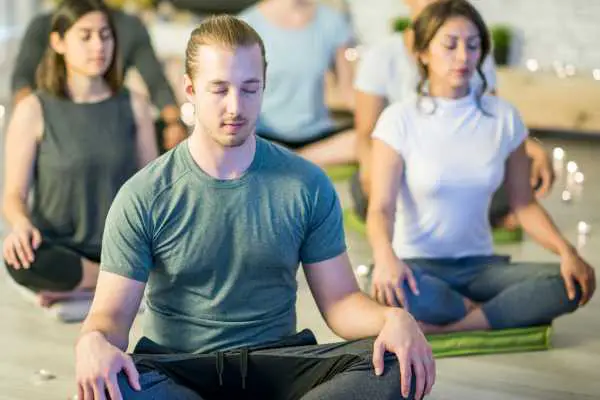Hey there, friends! Are you feeling stressed out, overwhelmed, or just generally frazzled? Well, have I got a solution for you: meditation!
If you’re already familiar with this ancient practice, you probably know that meditation has a ton of benefits, from reducing anxiety to improving focus and concentration.
But did you know that meditating twice a day might be even better than just doing it once?
Yes, you can meditate twice a day if you wish to. It is a good way to maintain consistency in your practice and can help you experience more benefits of meditation.
Yes, you heard that right: you could be doubling your meditation game and reaping even more rewards. But is it really okay to meditate two times a day? And if so, how do you do it?
Well, let’s dive in and find out!

What Are the Benefits of Doing Meditation More Than One Time a Day?
Let’s face it, life can be overwhelming sometimes. Between work, family, and personal responsibilities, it’s easy to feel stressed, anxious, and unfocused.
That’s where meditation comes in. And if you’re thinking of meditating twice a day, you’re in for a treat!
- Meditating twice a day can provide a variety of benefits, including improved focus and concentration, better stress management, and improved sleep and overall well-being.
- By meditating in the morning and evening, you can set the tone for your day and then unwind and release the stresses of the day before heading to bed.
- Meditating twice a day can also help you stay centered and grounded throughout the day, no matter what life throws your way.
- In addition to the mental benefits, meditating twice a day can also have physical benefits. Research has shown that meditation can improve heart health, lower blood pressure, and boost immune function.
And by meditating more than once a day, you may be able to maximize these benefits.
So, whether you’re looking to improve your mental or physical health, meditating twice a day could be just what the doctor ordered.
How Does Meditating Twice a Day Affect Your Brain and Body?
Meditation isn’t just a mental exercise, it also has a significant impact on your physical health. Meditating twice a day can positively affect both your brain and body in many ways.
One of the key benefits of meditation is its ability to change the structure and function of the brain.
Regular meditation practice can increase the thickness of the prefrontal cortex, the area of the brain responsible for decision-making and problem-solving.
It can also improve connectivity between different regions of the brain, enhancing overall cognitive function.
Meditation has also been shown to affect the body’s stress response. When we experience stress, our body releases the hormone cortisol, which can cause a range of negative health effects over time. Regular meditation can lower cortisol levels, reducing stress and anxiety.
In addition to reducing stress, meditation can also improve heart health.
Studies have shown that meditation can lower blood pressure, decrease the risk of heart disease, and improve overall cardiovascular function. It can also boost immune function, helping the body to fight off illness and disease.
Overall, meditating twice a day can have a profound impact on both the brain and body, promoting better overall health and well-being.

Should You Follow the Same Meditation Technique for Each Session?
So, you’ve decided to meditate twice a day and you’re feeling great about it! But now comes the question: should you stick to the same meditation technique for each session? The short answer is: not necessarily.
While it’s important to establish a consistent meditation practice, incorporating variety into your routine can help keep things fresh and engaging.
It can also provide different benefits depending on the technique you choose.
For example, if you’re feeling anxious or stressed, you might try a breathing meditation to calm your mind. On the other hand, if you’re struggling with focus and concentration, a visualization meditation could be more beneficial.
Experimenting with different techniques can also help you discover what works best for you and your unique needs.
Some people prefer more structured techniques like mindfulness meditation, while others enjoy more free-flowing methods like loving-kindness meditation.
That being said, it’s important to find a balance between trying new techniques and sticking to a routine. If you constantly switch up your meditation practice, you might find it difficult to establish a consistent habit.
On the other hand, if you never try anything new, you could become bored or stagnant in your practice.
Incorporating different techniques can also complement each other and enhance the benefits of your overall meditation practice.
For example, you could start your morning session with a breathing meditation to focus your mind and end your evening session with a body scan meditation to release any tension or stress from the day.
Ultimately, the most important thing is to find what works best for you and your individual needs. Don’t be afraid to experiment with different techniques and find a routine that feels both engaging and sustainable.
What Are Some Different Meditation Techniques You Can Try When Meditating Twice a Day?
When it comes to meditation, there is no one-size-fits-all approach. Different techniques work for different people and situations.
If you are considering meditating twice a day, you may want to experiment with different techniques to keep your practice fresh and engaging. Here are some popular meditation techniques to consider:
- Mindfulness Meditation
This technique involves focusing on the present moment and observing thoughts and emotions without judgment. It can help you cultivate awareness and improve your ability to manage stress.
- Transcendental Meditation
This technique involves the use of a mantra, a word or phrase that is repeated silently to help quiet the mind. It is said to promote deep relaxation and reduce stress.
- Loving-Kindness Meditation
This technique involves sending love and compassion to oneself and others. It can help you cultivate a sense of empathy and connection with others.
- Body Scan Meditation
This technique involves focusing on the sensations in different parts of the body, from the toes to the top of the head. It can help you cultivate awareness of physical sensations and reduce tension in the body.
- Visualization Meditation
This technique involves creating a mental image or scenario and focusing on it. It can help you cultivate a sense of calm and relaxation.
- Walking Meditation
This technique involves walking slowly and mindfully, focusing on the sensations of each step. It can help you cultivate awareness and reduce stress.
Remember, the key is to find a technique that works for you and to be consistent with your practice. Don’t be afraid to try different techniques and modify them as needed to suit your preferences and goals.

What Is the Best Time for Meditation?
Meditation can be practiced at any time of the day, but finding the best time for your practice can help you establish a consistent routine.
Here are some of the benefits of meditating at different times of the day:
1. Morning meditation
Starting your day with meditation can help you set a positive tone for the rest of your day. It can help you feel more grounded and centered, and set your intentions for the day ahead.
2. Evening meditation
Practicing meditation in the evening can help you wind down and release any stress or tension that has accumulated throughout the day. It can also help you prepare for a restful night’s sleep.
3. Mid-day meditation
Taking a break to meditate in the middle of the day can help you recharge and refocus. It can also help you manage stress and boost productivity for the rest of the day.
Ultimately, the best time to meditate is the time that works best for your schedule and allows you to practice consistently. Try experimenting with different times of day to see what feels best for you.
What Is the Recommended Duration for Each Meditation Session When Meditating Twice a Day?
So, you’ve decided to try meditating twice a day, but you may be wondering how long each session should be. Well, the answer to that question largely depends on your goals and experience level.
If you’re new to meditation, it’s generally recommended to start with shorter sessions, such as 10-15 minutes, and gradually work your way up to longer sessions as you become more comfortable.
On the other hand, if you’re a seasoned meditator, you may find that longer sessions of 30 minutes to an hour are more beneficial.
However, it’s important to balance the duration of your sessions with the frequency of your practice.
Meditating for shorter periods more frequently can be more effective than longer sessions.
For example, if you have limited time in the morning, you may choose to do a 10-minute session but aim to do two or three of these throughout the day.
Alternatively, if you have more time in the evening, you may choose to do a longer 30-minute session before bed.
Ultimately, the key is to find a balance that works for you and your lifestyle. Don’t worry too much about the exact duration of your sessions, but instead focus on making meditation a regular part of your daily routine.

How to Balance Meditation with Other Activities When Meditating Twice a Day?
Meditation is a wonderful tool for improving your well-being, but it can be challenging to incorporate it into your daily routine, especially if you are meditating twice a day.
To make meditation a sustainable practice, it’s important to balance it with other activities in your life. Here are some tips on how to do that:
- Prioritize your meditation practice
One of the keys to success with meditation is to make it a priority in your life.
Schedule your meditation sessions at times when you are less likely to be distracted or interrupted and treat them with the same level of importance as other appointments in your calendar.
- Make meditation a part of your morning routine
If you meditate first thing in the morning, you can set a positive tone for the rest of your day. Consider waking up a little earlier to make time for your meditation practice.
- Fit meditation into your lunch break
If you have a busy schedule, consider meditating during your lunch break. This can help you recharge and refocus for the rest of the day.
- Choose the right time for your second meditation session
If you are meditating twice a day, it’s important to choose a time for your second session that works for you.
Some people prefer to meditate in the evening to unwind after a busy day, while others find that mid-day meditation helps them stay focused and productive.
- Take breaks as needed
If you find that you are struggling to balance your meditation practice with other activities in your life, take a break and reassess your routine. It’s better to take a short break and come back to meditation with renewed energy than to push yourself too hard and risk burnout.
By balancing your meditation practice with other activities in your life, you can make it a sustainable habit that supports your overall well-being.
Is It Possible to Overdo Meditation by Meditating Twice a Day?
As with any practice, it is possible to overdo meditation. Over-meditation can lead to burnout, which can cause negative effects on both your mental and physical health.
Signs of over-meditation can include exhaustion, anxiety, irritability, and even physical pain.
If you start to notice these symptoms, it may be time to adjust your meditation practice.
You can do this by reducing the frequency or length of your sessions, or by taking a break altogether. It’s important to listen to your body and give it the rest it needs.
To find balance in your meditation practice, it’s helpful to start with a realistic goal.
If you’re just starting out, meditating twice a day may be too much to handle.
Instead, try meditating once a day and gradually increase the frequency as you build up your practice.
It’s also important to remember that meditation is just one part of your overall well-being. Make sure to take care of your physical health by getting enough sleep, eating a balanced diet, and exercising regularly.
By taking care of your body and mind, you’ll be better equipped to handle the demands of regular meditation practice.

How to Stay Motivated to Meditate Twice a Day?
Now that you know the benefits of meditating twice a day, you may be wondering how to stay motivated to keep up this practice.
Let’s face it: it’s easy to start something new, but it can be challenging to maintain it in the long run. Here are some tips to help you stay motivated to meditate twice a day:
- Set achievable goals
Start with small, achievable goals and work your way up. For example, if you’re new to meditation, aim to meditate for just five minutes each session.
As you become more comfortable with the practice, you can increase the duration of your sessions.
- Track your progress
Keeping track of your progress can help you stay motivated and see how far you’ve come.
Use a journal or an app to log your meditation sessions, and take note of any changes you notice in your mood, stress levels, or sleep.
- Find a community
Joining a meditation group or community can provide a sense of accountability and support.
You can share your experiences, ask questions, and get feedback from others who are on the same journey as you.
- Mix it up
Variety is the spice of life, and this applies to meditation too.
Experiment with different techniques, try meditating at different times of day and switch up your surroundings to keep your practice fresh and interesting.
- Practice self-compassion
Remember that meditation is a practice, not a destination. Be kind to yourself if you miss a session or if your mind wanders during meditation.
Don’t judge yourself harshly; instead, see each session as an opportunity to learn and grow.
By following these tips, you can stay motivated to meditate twice a day and reap the benefits of this powerful practice. Remember, consistency is key, so aim to make meditation a daily habit that you look forward to.
How to Create a Meditation Routine for Twice-a-Day Practice?
Now that you understand the benefits of meditating twice a day and the different techniques you can use, it’s time to create a consistent meditation routine that works for your lifestyle.
Here are some tips to help you establish a successful routine:
- Set aside dedicated time for meditation
Choose a specific time of day that works best for you and commit to meditating during that time.
Whether it’s first thing in the morning, during your lunch break, or in the evening before bed, make it a non-negotiable part of your daily routine.
- Start with shorter sessions
If you’re new to meditation or the idea of meditating twice a day, it’s important to start slowly and gradually build up your practice.
Begin with shorter sessions of 5-10 minutes and work your way up to longer sessions as you become more comfortable.
- Be consistent
Consistency is key when it comes to establishing a meditation routine. Try to meditate at the same time every day and make it a habit.
Even if you only have a few minutes to spare, take advantage of that time and commit to your practice.
- Personalize your routine
Everyone’s meditation routine will look different based on their preferences and lifestyle.
Experiment with different techniques and find what works best for you. You may also want to consider adding in other practices like yoga or breathwork to complement your meditation practice.
- Be flexible
While consistency is important, it’s also important to be flexible and adaptable. Life happens, and there may be days when you’re not able to stick to your usual routine.
Don’t beat yourself up about it, just do what you can and get back on track the next day.
By following these tips, you can create a meditation routine that fits seamlessly into your daily life and helps you reap the many benefits of meditating twice a day.

How to Overcome Challenges and Obstacles When Meditating Twice a Day?
Meditation, like any habit, requires discipline and persistence. Even with the best intentions, there will be times when it is challenging to maintain a consistent practice.
However, by anticipating potential challenges and developing strategies to overcome them, you can cultivate a sustainable and fulfilling meditation practice.
- Boredom
It’s common to feel restless or bored during meditation, especially when practicing the same technique repeatedly.
To combat this, experiment with different techniques, lengths, or times of day to keep your practice fresh and engaging.
You can also try guided meditations or group classes to receive guidance and motivation.
- Distractions
Finding a quiet space for meditation can be challenging, particularly if you have a busy household or work environment.
Try creating a designated meditation space or wearing noise-cancelling headphones to minimize distractions.
Additionally, consider waking up earlier or staying up later to find a time when distractions are minimal.
- Lack of Time
Balancing work, family, and other responsibilities can make it challenging to find time for meditation.
However, remember that even a short meditation session can be beneficial.
Consider starting with five or ten minutes each day and gradually increasing the duration as your schedule allows.
- Burnout
Meditating twice a day may be beneficial, but it’s crucial to avoid overdoing it.
If you feel burned out or overwhelmed, take a break from meditation or reduce the frequency or duration of your sessions. Remember, consistency is key, but so is self-care.
By recognizing and addressing these challenges, you can create a sustainable meditation practice that enhances your physical, mental, and emotional well-being.
With patience, persistence, and a willingness to experiment, you can enjoy the benefits of meditating twice a day for years to come.
Conclusion
Congratulations! You’ve made it to the end of this article and have learned all about meditating twice a day. We hope that you found this information useful and inspiring.
To sum up, meditating twice a day can provide numerous benefits for your physical and mental well-being.
It can help improve focus and concentration, manage stress and anxiety, and even improve your sleep quality.
While meditating twice a day may seem like a daunting task, it is definitely achievable. With the right mindset, discipline, and motivation, you can make this a consistent part of your daily routine.
Remember, the key to success in meditation practice is consistency. It’s not about being perfect, but rather about making a commitment to yourself and sticking to it.
So, start small, set achievable goals, and celebrate your progress along the way.
We encourage you to explore different meditation techniques, find what works best for you, and create a personalized meditation routine that fits your schedule and preferences.
Thank you for taking the time to read this article, and we wish you all the best on your meditation journey.
Frequently Asked Questions
What is the biggest problem in meditation?
One of the biggest problems in meditation is the tendency to get distracted or lost in thought.
This is natural and normal, but it can be frustrating for beginners who may struggle to quiet their mind. Another common problem is falling asleep during meditation, especially if you’re practicing at the end of a long day.
It’s important to remember that meditation is a practice, and like any skill, it takes time and consistent effort to develop.
Which personality type meditates the most?
There isn’t a specific personality type that meditates the most. Meditation is a practice that can be beneficial for everyone, regardless of personality type.
People from all walks of life, with different personalities, backgrounds, and beliefs, practice meditation to improve their mental and physical well-being.
Some may find certain types of meditation more suitable for their personality or preferences, but ultimately, anyone can benefit from incorporating meditation into their daily routine.
When I meditate, why do I hear a sound?
It is not uncommon for individuals to experience various sounds during meditation, such as ringing, buzzing, or humming.
These sounds are known as “meditation sounds” or “auditory hallucinations” and can be a part of the meditative experience.
These sounds are not indicative of any medical or psychological condition and are generally harmless.
Some people find these sounds distracting, while others may find them helpful in reaching deeper levels of relaxation during meditation.
It is important to note that while these sounds can be a part of the meditative experience, they should not be the focus of the meditation. The focus should remain on the breath or the chosen object of meditation.




